Comparing Iconicity Trade-Offs in Cena and Libras during a Sign Language Production Task
Abstract
:1. Introduction
1.1. Classifiers in Sign Languages
1.1.1. An Overview
- Whole entity classifiers, in which the hand or hands directly represent a whole object. They denote a general class of objects (e.g., people, vehicles, four-legged animals) using some aspect of their form, though their iconicity can vary in its transparency. Some consider this category to include SaSSes (e.g., Zwitserlood 2012), while others do not (Morgan and Woll 2007).
- Handling classifiers, which denote an object through depicting the handling or manipulation of the object in question, e.g., holding a mobile phone, or turning a key. These often still provide some information about the size and/or form of the object, although indirectly.
 .
.1.1.2. The Phonology of Classifiers
 . Over time, young signers are replacing this handshape with
. Over time, young signers are replacing this handshape with  , wherein the index finger is extended rather than the middle. What this newer variant may lose in iconicity, it gains in ease. Only the thumb, index, and pinky fingers are controlled by muscles that allow them to extend independently with no adjacent digit to support them (Ann 2006, p. 94). This pull towards articulatorily ease appears strong enough to transcend the lone domain of handshape. The movement features of VIDEOTAPE-RECORDER in ASL have shifted from being asymmetrical—depicting the way in which the reels really move—to being symmetrical (Figure 3). The motivation from articulatory ease is clear. Human physiology is marked by bilateral symmetry, and as such movements that are symmetrical from the midline of the body can be specified for only one path of movement, rather than the two that asymmetrical movements require. Empirically, studies on symmetry in gesture (in hearing non-sign language-learning infants) and sign (in deaf sign language-learning infants) in young children support the idea that two-handed symmetrical movement is articulatorily easier than two-handed asymmetrical movement (Fagard 1994; Cheek et al. 2001; Pettenati et al. 2010). We take this as strong evidence of their relative ease, analogously to how factors such as infant substitutions and error shape conclusions about the relative difficulty of sounds in spoken language.
, wherein the index finger is extended rather than the middle. What this newer variant may lose in iconicity, it gains in ease. Only the thumb, index, and pinky fingers are controlled by muscles that allow them to extend independently with no adjacent digit to support them (Ann 2006, p. 94). This pull towards articulatorily ease appears strong enough to transcend the lone domain of handshape. The movement features of VIDEOTAPE-RECORDER in ASL have shifted from being asymmetrical—depicting the way in which the reels really move—to being symmetrical (Figure 3). The motivation from articulatory ease is clear. Human physiology is marked by bilateral symmetry, and as such movements that are symmetrical from the midline of the body can be specified for only one path of movement, rather than the two that asymmetrical movements require. Empirically, studies on symmetry in gesture (in hearing non-sign language-learning infants) and sign (in deaf sign language-learning infants) in young children support the idea that two-handed symmetrical movement is articulatorily easier than two-handed asymmetrical movement (Fagard 1994; Cheek et al. 2001; Pettenati et al. 2010). We take this as strong evidence of their relative ease, analogously to how factors such as infant substitutions and error shape conclusions about the relative difficulty of sounds in spoken language. handshape6, which is considered unmarked (Battison 1978) and is frequent crosslinguistically in classifiers (Zwitserlood 2012). Its relative frequency in classifiers across languages is likely at least partially grounded in its ubiquity as a manual configuration for handling objects. As the model of Brentari et al. is motivated primarily by representational complexity, such a model will overlook influences of this type.
handshape6, which is considered unmarked (Battison 1978) and is frequent crosslinguistically in classifiers (Zwitserlood 2012). Its relative frequency in classifiers across languages is likely at least partially grounded in its ubiquity as a manual configuration for handling objects. As the model of Brentari et al. is motivated primarily by representational complexity, such a model will overlook influences of this type.1.1.3. Manner and Path in Motion Events
1.2. The Current Study
Predictions
1.3. Language Profiles
1.3.1. Libras
1.3.2. Cena
1.3.3. Typological Considerations
2. Materials and Methods
2.1. Participants
2.2. Materials and Task
2.3. Analysis
3. Results
3.1. Accuracy
3.2. Handshape
 handshape appearing in Cena entity classifiers, and the slightly open version
handshape appearing in Cena entity classifiers, and the slightly open version  in Libras entity classifiers. At a glance, the results seem to support our prediction for Hypothesis 2 (that of greater intersigner variation in Cena) when considering entity classifiers, since more handshape variants were attested in Cena than Libras. For size and shape specifier handshapes, our prediction was not borne out as the number of handshapes attested across the languages was the same. An evaluation of Hypothesis 1 (that of greater handshape complexity in Cena classifier handshapes) requires assigning complexity scores and determining whether there is a statistically significant difference in the distribution of scores across the two languages, which follows in Section 4.1.
in Libras entity classifiers. At a glance, the results seem to support our prediction for Hypothesis 2 (that of greater intersigner variation in Cena) when considering entity classifiers, since more handshape variants were attested in Cena than Libras. For size and shape specifier handshapes, our prediction was not borne out as the number of handshapes attested across the languages was the same. An evaluation of Hypothesis 1 (that of greater handshape complexity in Cena classifier handshapes) requires assigning complexity scores and determining whether there is a statistically significant difference in the distribution of scores across the two languages, which follows in Section 4.1.3.3. Movement
4. Discussion
4.1. Handshape
 in the data, which is a departure from both iconicity (having no obvious semantic motivation) and finger and joint simplicity. Looking at the classifier within the phrase provides clues. The handshape was only attested (n = 3 from two different participants) in cases where the sign WATER—which is specified for the same handshape, although the thumb is not visible in the first image in the following example—preceded the classifier. An example sequence is shown in Figure 12. This appears to be a case of handshape assimilation. Similar to spoken languages where a feature of a particular sound (such as place of articulation, or voicing) may spread onto its neighbour, sublexical features of a particular sign may also spread onto adjacent signs. In this case, the handshape in WATER remains throughout the following classifier.
in the data, which is a departure from both iconicity (having no obvious semantic motivation) and finger and joint simplicity. Looking at the classifier within the phrase provides clues. The handshape was only attested (n = 3 from two different participants) in cases where the sign WATER—which is specified for the same handshape, although the thumb is not visible in the first image in the following example—preceded the classifier. An example sequence is shown in Figure 12. This appears to be a case of handshape assimilation. Similar to spoken languages where a feature of a particular sound (such as place of articulation, or voicing) may spread onto its neighbour, sublexical features of a particular sign may also spread onto adjacent signs. In this case, the handshape in WATER remains throughout the following classifier. handshape only appears as an entity classifier when preceded by a SaSS depicting the bottle’s cylindrical shape using the same handshape (n = 4 from one participant), as in Figure 13. Of course, a phonological explanation is not the only type possible. Such variants could be motivated by reasons of semantics17, in that the handshapes signers select may be motivated by semantic properties determined by certain experiences (or lack thereof) with objects, or certain semantic properties the signers feel to be salient in the object in the stimulus. To tease this apart, one could elicit depictions of different types of the same object, perhaps forms varying in colour, material, or intended use. This would not only foreground different semantic associations, but ideally also encourage varied lexical items preceding or following the classifiers to further investigate a hypothesis of assimilation. However, when we revisit one specific production, additional evidence for assimilation emerges. In Figure 14, a signer produces an account of the bottle falling. It begins with the sign WATER, with its
handshape only appears as an entity classifier when preceded by a SaSS depicting the bottle’s cylindrical shape using the same handshape (n = 4 from one participant), as in Figure 13. Of course, a phonological explanation is not the only type possible. Such variants could be motivated by reasons of semantics17, in that the handshapes signers select may be motivated by semantic properties determined by certain experiences (or lack thereof) with objects, or certain semantic properties the signers feel to be salient in the object in the stimulus. To tease this apart, one could elicit depictions of different types of the same object, perhaps forms varying in colour, material, or intended use. This would not only foreground different semantic associations, but ideally also encourage varied lexical items preceding or following the classifiers to further investigate a hypothesis of assimilation. However, when we revisit one specific production, additional evidence for assimilation emerges. In Figure 14, a signer produces an account of the bottle falling. It begins with the sign WATER, with its  handshape remaining over a string of several subsequent signs including a lexicalised sign, two classifiers, and an indexical point. DRINK, which appears in the middle of this string, is a conventionalised sign with the
handshape remaining over a string of several subsequent signs including a lexicalised sign, two classifiers, and an indexical point. DRINK, which appears in the middle of this string, is a conventionalised sign with the  handshape, yet the presence of the extended index finger in this production is evident. We take this as robust evidence for assimilation, and thus apply the same hypothesis to the case of the curved
handshape, yet the presence of the extended index finger in this production is evident. We take this as robust evidence for assimilation, and thus apply the same hypothesis to the case of the curved  handshape in entity classifiers, given its similar distribution only following another classifier with the same handshape. It seems that in entity classifiers that used
handshape in entity classifiers, given its similar distribution only following another classifier with the same handshape. It seems that in entity classifiers that used  and
and  , any constraints on markedness or complexity were violated by virtue of other influences from phonology—assimilation. In the case of WATER, the influence of phonology in pulling sign form away from faithfulness to semantics or iconicity is particularly clear.
, any constraints on markedness or complexity were violated by virtue of other influences from phonology—assimilation. In the case of WATER, the influence of phonology in pulling sign form away from faithfulness to semantics or iconicity is particularly clear. handshape has only high joint complexity since all the fingers are selected and act in unison. The less frequent thumb-opposed
handshape has only high joint complexity since all the fingers are selected and act in unison. The less frequent thumb-opposed  handshape scores highly both in finger and joint complexity. There are many handshapes available to signers to depict curvature:
handshape scores highly both in finger and joint complexity. There are many handshapes available to signers to depict curvature:  ,
,  ,
,  to list a few in addition to those in the data. Iconic depiction of curvature using handshape is likely to tip the balance out of favour with articulatory ease. As the quantification models of both Brentari et al. (2012) and Ann (2006) show, extended, closed, and flat handshapes all require less articulatory effort than curved ones. Within this small subcategory of handshapes in the data that depicted curvature, we still see the easiest one prevail—the curved
to list a few in addition to those in the data. Iconic depiction of curvature using handshape is likely to tip the balance out of favour with articulatory ease. As the quantification models of both Brentari et al. (2012) and Ann (2006) show, extended, closed, and flat handshapes all require less articulatory effort than curved ones. Within this small subcategory of handshapes in the data that depicted curvature, we still see the easiest one prevail—the curved  handshape. In the choice of handshape to depict the form of the bottle overall, iconicity may have won the trade-off initially, but within the variants selected for that choice, pressures from ease endure.
handshape. In the choice of handshape to depict the form of the bottle overall, iconicity may have won the trade-off initially, but within the variants selected for that choice, pressures from ease endure. handshape is the only entity classifier handshape to receive a high joint complexity score. Every token of this entity classifier directly followed a SaSS depicting the object’s curvature, of the form shown in Figure 13. This was a common strategy among Libras signers, to first depict the object’s extension before depicting the verb event: 82% of Libras entity classifiers involved in verb events were directly preceded by a SaSS that depicted the size or form of the bottle, e.g., CL:SaSS(height) CL:TALL-OBJECT-FALL, as opposed to only 30% of Cena entity classifiers. The greater relative consistency with which Libras signers used this ordered construction may have had an effect on the distribution of handshapes with regards to assimilation, considering the evidence for assimilation in the same environment in Cena. Among the SaSSes, handshapes receiving high finger or joint complexity scores were involved in depictions of curvature. As the most frequent SaSS handshape fell into this category, the curved
handshape is the only entity classifier handshape to receive a high joint complexity score. Every token of this entity classifier directly followed a SaSS depicting the object’s curvature, of the form shown in Figure 13. This was a common strategy among Libras signers, to first depict the object’s extension before depicting the verb event: 82% of Libras entity classifiers involved in verb events were directly preceded by a SaSS that depicted the size or form of the bottle, e.g., CL:SaSS(height) CL:TALL-OBJECT-FALL, as opposed to only 30% of Cena entity classifiers. The greater relative consistency with which Libras signers used this ordered construction may have had an effect on the distribution of handshapes with regards to assimilation, considering the evidence for assimilation in the same environment in Cena. Among the SaSSes, handshapes receiving high finger or joint complexity scores were involved in depictions of curvature. As the most frequent SaSS handshape fell into this category, the curved  handshape, it seems iconicity and semantics won this particular trade-off.
handshape, it seems iconicity and semantics won this particular trade-off. handshape was the most populous across both languages, accouting for the large proportion of scores of 3. Handshapes with the highest joint complexity (with a score of 4) were those that are stacked, also depicting the curvature of the referent.
handshape was the most populous across both languages, accouting for the large proportion of scores of 3. Handshapes with the highest joint complexity (with a score of 4) were those that are stacked, also depicting the curvature of the referent. handshape does not appear to exemplify this idea, seeing as it has a relatively high joint complexity score. However, if we recall that it is crosslinguistically frequent and is considered unmarked, it appears more as a discrepancy between using a model of complexity primarily based on representational simplicity, as opposed to models based on markedness or ease of articulation. That is, measures of complexity based on representational complexity (such as that of Brentari et al. 2012) do not capture certain realities of usage that likely affect handshape distribution in classifiers, including the pervasiveness of the curved
handshape does not appear to exemplify this idea, seeing as it has a relatively high joint complexity score. However, if we recall that it is crosslinguistically frequent and is considered unmarked, it appears more as a discrepancy between using a model of complexity primarily based on representational simplicity, as opposed to models based on markedness or ease of articulation. That is, measures of complexity based on representational complexity (such as that of Brentari et al. 2012) do not capture certain realities of usage that likely affect handshape distribution in classifiers, including the pervasiveness of the curved  handshape as a manual configuration for grasping objects outside of the linguistic system. The prevalence of such a handshape in the data may seem surprising when considered through the lens of complexity as defined by representational complexity alone, but its ubiquity both as a handshape crosslinguistically, and as a configuration for the non-linguistic manipulation of objects goes far in accounting for this.
handshape as a manual configuration for grasping objects outside of the linguistic system. The prevalence of such a handshape in the data may seem surprising when considered through the lens of complexity as defined by representational complexity alone, but its ubiquity both as a handshape crosslinguistically, and as a configuration for the non-linguistic manipulation of objects goes far in accounting for this.4.2. Movement
5. Conclusions
 handshape of WATER spread over a whole phrase by one Cena signer), just not from the source we had anticipated.
handshape of WATER spread over a whole phrase by one Cena signer), just not from the source we had anticipated.Author Contributions
Funding
Institutional Review Board Statement
Informed Consent Statement
Data Availability Statement
Acknowledgments
Conflicts of Interest
Appendix A
| Handshape | Example in Text |
|---|---|
 | BSL vehicle classifier/Cena SaSS |
 | ASL vehicle classifier |
 | HKSL airplane classifier (old) |
 | HKSL airplane classifier (new) |
 | Low finger complexity handshape/Cena entityclassifier |
 | Low finger complexity handshape |
 | Medium finger complexity handshape |
 | Medium finger complexity handshape |
 | High finger complexity handshape |
 | High finger complexity handshape |
 | High finger complexity handshape |
 | Flat handshape |
 | Extended handshape |
 | Curved handshape |
 | Bent handshape |
 | Stacked handshape |
 | Crossed handshape |
 | Cena SaSS |
 | Libras SaSS |
| 1 | See Zwitserlood (2012, p. 175) for discussion of the similarities and differences of classifiers in signed and spoken languages. |
| 2 | See Appendix A for a list of all handshapes appearing in the text. |
| 3 | Entities can be specified for manner and path movement features, which may or may not be encoded at all, and if so, sequentially or simultaneously. Therefore signers have more choices available in the encoding of movement features. Discussion on this topic will follow later in this section. |
| 4 | See Brentari et al. (2012, p. 7) for a justification of this choice concerning potential alternate results using other models. |
| 5 | We guide the reader to Van der Hulst and van de Weijer (2017) for an overview of the theory of Dependency Phonology. |
| 6 | We thank the editor for this observation. |
| 7 | The most notabe being that in Ann’s model, flat handshapes receive a difficulty score one increment lower than that of extended handshapes. |
| 8 | Recall that object classifiers broadly correspond to entity classifiers. |
| 9 | Supalla (1990, p. 132) provides ‘person limping in a circle’ as one such example in ASL. |
| 10 | cf. de Quadros (2020) for a recent and detailed volume dedicated to studies on Libras. |
| 11 | We also direct readers to the short film Jogos Dirigidos (‘Directed Games’) by Jonathas de Andrade (Internationale Filmfestspiele Berlin 2020), in which deaf signers recount narratives and play theatre games in Várzea Queimada. |
| 12 | Introduced in 2003, the Bolsa Famíla program provides financial aid to low-income families provided they meet certain conditions, such as sending their children to school. Many families in Várzea Queimada are recipients, travelling to the nearest city Jaicós to collect this aid. |
| 13 | We thank Telma Franco, Bruna da Silva Neres, Silvana, and Marcilene for recording the census data with the community. |
| 14 | Meir and Sandler (2019) discuss a classifier-like suffix in ABSL in the context of compound formation. |
| 15 | The implications within language typology from the study of Kata Kolok and Adamorobe Sign Language are still very relevant to our study since Cena and Libras do not just differ in age, but also along the axis of being a village and an urban sign language, respectively. |
| 16 | Ages are approximate as reported verbally to our research team by members of the community. |
| 17 | We thank our reviewer for this insightful suggestion. |
| 18 | We guide readers interested in a stimuli set specifically designed to elicit linguistic and gestural depictions of motion events with a focus on manner and path towards Özyürek et al. (2001). Few tokens appear for the ball rolling stimulus, as signers often only depicted the path of the movement or the cause of the event, i.e., BALL THROW. As these are neither simultaneous or sequential, we excluded such responses from the analysis. |
| 19 | See Brentari et al. (2021) for discussion of the importance of vertical contact in the emergence and development of various levels of linguistic structure in young sign languages. |
References
- Almeida-Silva, Anderson. Forthcoming. Avaliação de Comunidades Surdas Urbanas e Isoladas. Unpublished Project PRPPG/UFPI—CRMV 003/2013. Piauí: Universidade Federal do Piauí.
- Almeida-Silva, Anderson, and Andrew Ira Nevins. 2020. Notas sobre a estrutura linguística da Cena: A língua de sinais emergente da Várzea Queimada (Piauí, Brasil). Linguagem & Ensino 23: 1029–53. [Google Scholar] [CrossRef]
- Ann, Jean. 2006. Frequency of Occurrence and Ease of Articulation of Sign Language Handshapes: The Taiwanese Example. Washington, DC: Gallaudet University Press. [Google Scholar]
- Battison, Robbint. 1978. Lexical Borrowing in American Sign Language. Silver Spring, MD: Linstok Press. [Google Scholar]
- Boyes Braem, Penny. 1981. Distinctive Features of the Handshapes of American Sign Language. Ph.D. dissertation, University of California, Berkeley, CA, USA. [Google Scholar]
- Boyes Braem, Penny. 1990. Acquisition of the handshape in American Sign Language: Preliminary analysis. In From Gesture to Language in Hearing and Deaf Children. Edited by Virginia Volterra and Carol J. Erting. Heidelberg: Springer, pp. 107–27. [Google Scholar]
- Brentari, Diane. 1998. A Prosodic Model of Sign Language Phonology. Cambridge: MIT Press. [Google Scholar]
- Brentari, Diane, Marie Coppola, Laura Mazzoni, and Susan Goldin-Meadow. 2012. When does a system become phonological? Handshape production in gesturers, signers, and homesigners. Natural Language and Linguistic Theory 30: 1–31. [Google Scholar] [CrossRef] [PubMed]
- Brentari, Diane, and Petra Eccarius. 2010. Handshape contrasts in sign language phonology. In Sign Languages. Edited by Diane Brentari. Cambridge: Cambridge University Press, pp. 284–311. [Google Scholar]
- Brentari, Diane, Marie Coppola, Pyeong Whan Cho, and Anne Senghas. 2016. Handshape complexity as a precursor to phonology: Variation, emergence, and acquisition. Language Acquisition 24: 283–306. [Google Scholar] [CrossRef] [PubMed]
- Brentari, Diane, Rabia Ergin, Anne Senghas, Pyeong Whan Cho, Eli Owens, and Marie Coppola. 2021. Community interactions and phonemic inventories in emerging sign languages. Phonology 38: 571–609. [Google Scholar] [CrossRef]
- Cheek, Adrianne, Kearsy Cormier, Ann Repp, and Richard P. Meier. 2001. Prelinguistic Gesture Predicts Mastery and Error in the Production of Early Signs. Language 77: 292–323. [Google Scholar] [CrossRef]
- Cormier, Kearsy, David Quinto-Pozos, Zed Sevcikova, and Adam Schembri. 2012. Lexicalisation and de-lexicalisation processes in sign languages: Comparing depicting constructions and viewpoint gestures. Language & Communication 32: 329–48. [Google Scholar] [CrossRef] [Green Version]
- De Beuzeville, Louise A. 2004. A description of the acquisition of classifiers in Auslan (Australian Sign Language) by deaf and hearing children of deaf parents. Australian Journal of Education of the Deaf 10: 43–50. [Google Scholar]
- de Quadros, Ronice M. 2020. Brazilian Sign Language Studies. Berlin and Boston: De Gruyter Mouton. [Google Scholar] [CrossRef]
- de Vos, Connie. 2012. Sign-Spatiality in Kata Kolok. Ph.D. dissertation, Radboud University Nijmegen, Nijmegen, The Netherlands. [Google Scholar]
- de Vos, Connie, and Roland Pfau. 2015. Sign Language Typology: The Contribution of Rural Sign Languages. Annual Review of Linguistics 1: 265–88. [Google Scholar] [CrossRef] [Green Version]
- Eccarius, Petra. 2008. A Constraint-Based Account of Handshape Contrast in Sign Languages. Ph.D. dissertation, Purdue University, West Lafayette, Indiana. [Google Scholar]
- Engberg-Pedersen, Elisabeth. 2010. Factors that form classifier signs. In Sign Languages. Edited by Diane Brentari. Cambridge: Cambridge University Press, pp. 252–83. [Google Scholar] [CrossRef]
- Ergin, Rabia, Irit Meir, Deniz Ilkbaşaran, Carol Padden, and Ray Jackendoff. 2018. The development of argument structure in Central Taurus sign language. Sign Language Studies 18: 612–39. [Google Scholar] [CrossRef]
- Fagard, Jacqueline. 1994. Manual strategies and interlimb coordination during reaching, grasping, and manipulating throughout the first year of life. In Interlimb Coordination: Neural, Dynamical, and Cognitive Constraints. Edited by Stephan P. Swinnen, H. Heuer, Jean Massion and P. Casaer. Cambridge, MA: Academic Press, pp. 439–60. [Google Scholar] [CrossRef]
- Franco, Telma. 2022. Escolarização do surdo plurilíngue de Várzea Queimada/PI (concepção dos professores). Unpublished postgraduate thesis, Universidade Federal do Piauí, Piauí, Brazil. [Google Scholar]
- Frishberg, Nancy. 1975. Arbitrariness and iconicity: Historical change in American Sign Language. Language 51: 696–719. [Google Scholar] [CrossRef]
- Fusellier-Souza, Ivani. 2004. Sémiogenèse des langues des signes: Étude de langues des signes primaires (LSP) pratiquées par des sourds brésiliens. Ph.D. dissertation, Université Paris 8, Paris, France. [Google Scholar]
- Godoy, Gustavo. 2020. Os Ka’apor: Seus gestos e sinais. Ph.D. dissertation, Universidade Federal do Rio de Janeiro, Rio de Janeiro, Brazil. [Google Scholar]
- Hou, Lynn Yong-Shi. 2016. “Making Hands”: Family Sign Languages in the San Juan Quiahije Community. Ph.D. Dissertation, University of Texas, Austin, TX, USA. [Google Scholar]
- Internationale Filmfestspiele Berlin. 2020. Jogos Dirigidos. Available online: https://web.archive.org/web/20211013080727/https%3A%2F%2Fwww.berlinale.de%2Fen%2Farchive-selection%2Farchive-2020%2Fprogramme%2Fdetail%2F202011689.html (accessed on 10 October 2021).
- Israel, Assaf, and Wendy Sandler. 2011. Phonological category resolution in a new sign language: A comparative study of handshapes. In Formational Units in Sign Languages. Edited by Rachel Channon and Harry van der Hulst. Berlin: De Gruyter, pp. 177–202. [Google Scholar]
- Johnston, Trevor, and Adam Schembri. 2007. Australian Sign Language (Auslan): An Introduction to Sign Language Linguistics. Cambridge: Cambridge University Press. [Google Scholar]
- Kegl, Judy, Anne Senghas, and Marie Coppola. 1999. Creation through contact: Sign language emergence and sign language change in Nicaragua. In Language Creation and Language Change: Creolization, Diachrony, and Development. Edited by Michel DeGraff. Cambridge, MA: MIT Press, pp. 179–237. [Google Scholar]
- Klima, Edward S., and Ursula Bellugi. 1979. The Signs of Language. Cambridge: Harvard University Press. [Google Scholar]
- Kusters, Annelies. 2010. Deaf utopias? Reviewing the sociocultural literature on the world’s “Martha’s Vineyard situations”. Journal of Deaf Studies and Deaf Education 15: 3–16. [Google Scholar] [CrossRef] [PubMed]
- Mandel, Mark A. 1979. Natural constraints in sign language phonology: Data from anatomy. Sign Language Studies 24: 215–29. [Google Scholar] [CrossRef]
- Marsaja, I. Gede. 2008. Desa Kolok—A Deaf Village and Its Sign Language in Bali, Indonesia. Nijmegen: Ishara Press. [Google Scholar]
- Meir, Irit. 2010. The Emergence of Argument Structure in Two New Sign Languages. In Syntax, Lexical Semantics, and Event Structure. Edited by Malka R. Hovav, Edit Doron and Ivy Sichel. Oxford: Oxford University Press, pp. 101–13. [Google Scholar]
- Meir, Irit, Assaf Israel, Wendy Sandler, Carol Padden, and Mark Aronoff. 2012. The influence of community on language structure: Evidence from two young sign languages. Linguistic Variation 12: 247–91. [Google Scholar] [CrossRef]
- Meir, Irit, and Wendy Sandler. 2019. Variation and conventionalization in language emergence. In Language Contact, Continuity and Change in the Genesis of Modern Hebrew. Edited by Edit Doron, Malka Rappaport Hovav, Yael Reshef and Moshe Taube. Amsterdam: John Benjamins Publishing Company, pp. 285–301. [Google Scholar] [CrossRef]
- Meir, Irit, Mark Aronoff, Carl Börstell, So One Hwang, Deniz Ilkbaşaran, Itamar Kastner, Ryan Lepic, Adi Lifshitz Ben-Basat, Carol Padden, and Wendy Sandler. 2017. The effect of being human and the basis of grammatical word order: Insights from novel communication systems and young sign languages. Cognition 158: 189–207. [Google Scholar] [CrossRef] [PubMed]
- Meir, Irit, Wendy Sandler, Carol Padden, and Mark Aronoff. 2010. Emerging Sign Languages. In The Oxford Handbook of Deaf Studies, Language, and Education. Edited by Marc Marschark and Patricia E. Spencer. Oxford: Oxford University Press, vol. 2, pp. 267–80. [Google Scholar]
- Morgan, Gary, Sarah Barrett-Jones, and Helen Stoneham. 2007. The first signs of language: Phonological development in British Sign Language. Applied Psycholinguistics 28: 3–22. [Google Scholar] [CrossRef] [Green Version]
- Morgan, Gary, and Bencie Woll. 2007. Understanding sign language classifiers through a polycomponential approach. Lingua 117: 1159–68. [Google Scholar] [CrossRef]
- Newport, Elissa L., and Richard P. Meier. 1985. The acquisition of American Sign Language. In The Crosslinguistic Study of Language Acquisition. Edited by Dan I. Slobin. Mahwah: Lawrence Erlbaum Associates Inc., vol. 1, pp. 881–938. [Google Scholar]
- Nyst, Victoria. 2007. A Descriptive Analysis of Adamorobe Sign Language (Ghana). Ph.D. dissertation, University of Amsterdam, Amsterdam, The Netherlands. [Google Scholar]
- Nyst, Victoria. 2012. Shared sign languages. In Sign Language: An International Handbook. Edited by Roland Pfau, Markus Steinbach and Bencie Woll. Berlin: Walter de Gruyter, pp. 552–74. [Google Scholar]
- Nyst, Victoria. 2019. The impact of cross-linguistic variation in gesture on sign language phonology and morphology: The case of size and shape specifiers. Gesture 18: 343–69. [Google Scholar] [CrossRef]
- Oomen, Marloes. 2016. The marking of two aspectual distinctions in Sign Language of the Netherlands (NGT). Linguistics in Amsterdam 9: 30–55. [Google Scholar]
- Özyürek, Asli, Sotaro Kita, and Shanley Allen. 2001. Tomato Man Movies: Stimulus Kit Designed to Elicit Manner, Path and Causal Constructions in Motion Events with Regard to Speech and Gestures. Nijmegen: Max Planck Institute for Psycholinguistics, Language and Cognition group. [Google Scholar]
- Padden, Carol A., Irit Meir, Wendy Sandler, and Mark Aronoff. 2010. Against All Expectations: Encoding Subjects and Objects in a New Language. In Hypothesis A/Hypothesis B: Linguistic Explorations in Honor of David M. Perlmutter. Cambridge, MA: MIT Press, pp. 383–400. [Google Scholar] [CrossRef] [Green Version]
- Pereira, Éverton L. 2013. Fazendo cena na cidade dos mudos: Surdez, práticas sociais e uso da língua em uma localidade no sertão do Piauí. Ph.D. dissertation, Universidade Federal de Santa Catarina, Florianópolis, Brazil. [Google Scholar]
- Pettenati, Paola, Silvia Stefanini, and Virginia Volterra. 2010. Motoric characteristics of representational gestures produced by young children in a naming task. Journal of Child Language 37: 887–911. [Google Scholar] [CrossRef]
- Rozelle, Lorna. 2003. The Structure of Sign Language Lexicons: Inventory and Distribution of Handshape and Location. Ph.D. dissertation, University of Washington, Washington, DC, USA. [Google Scholar]
- Sandler, Wendy, Irit Meir, Carol Padden, and Mark Aronoff. 2005. The emergence of grammar: Systematic structure in a new language. Proceedings of the National Academy of Sciences of the United States of America 102: 2661–65. [Google Scholar] [CrossRef] [PubMed] [Green Version]
- Sandler, Wendy, Mark Aronoff, Irit Meir, and Carol Padden. 2011. The gradual emergence of phonological form in a new Language. Natural Language and Linguistic Theory 29: 503–43. [Google Scholar] [CrossRef] [PubMed] [Green Version]
- Schembri, Adam. 2010. Documenting sign languages. In Language Documentation and Description. Edited by P. K. Austin. London: SOAS, vol. 7, pp. 105–43. [Google Scholar]
- Schembri, Adam, Caroline Jones, and Denis Burnham. 2005. Comparing action gestures and classifier verbs of motion: Evidence from Australian Sign Language, Taiwan Sign Language, and nonsigners’ gestures without speech. Journal of Deaf Studies and Deaf Education 10: 272–90. [Google Scholar] [CrossRef] [PubMed] [Green Version]
- Senghas, Anne, Asli Özyurek, and Susan Goldin-Meadow. 2010. The evolution of segmentation and sequencing: Evidence from homesign and Nicaraguan Sign Language. In The Evolution of Language. Edited by Andrew D. M. Smith, Marieke Schouwstra, Bart de Boer and Kenny Smith. Singapore: World Scientific Publishing Co., pp. 279–89. [Google Scholar]
- Senghas, Anne, and Sarah Littman. 2004. Segmentation in the expression of motion events in co-speech gesture, Nicaraguan Sign Language (NSL) and Spanish Sign Language (LSE). Presented at the Eighth International Conference on Theoretical Issues in Sign Language Research (TISLR8), Barcelona, Spain, 30 September–2 October. [Google Scholar]
- Senghas, Anne. 1995. Children’s contribution to the birth of Nicaraguan Sign Language. Ph.D. dissertation, Massachusetts Institute of Technology, Cambridge, MA, USA. [Google Scholar]
- Senghas, Anne, Sotaro Kita, and Asli Özyürek. 2004. Children creating core properties of language: Evidence from an emerging sign language in Nicaragua. Science 305: 1779–82. [Google Scholar] [CrossRef] [Green Version]
- Silva, S. Diná. 2021. Inventário das línguas de sinais dos vilarejos brasileiros: O caso da Cena (Jaicós—PI) e da língua de sinais de Caiçara (Várzea Alegre—CE). Ph.D. Dissertation, Universidade Federal de Santa Catarina, Florianópolis, Brazil. [Google Scholar]
- Stoianov, Diane, and Andrew Nevins. 2017. The phonology of handshape distribution in Maxakalí sign. In Sonic Signatures. Edited by Geoff Lindsey and Andrew Nevins. Amsterdam: John Benjamins, pp. 232–62. [Google Scholar]
- Supalla, Ted. 1982. Structure and Acquisition of Verbs of Motion and Location in American Sign Language. Ph.D. dissertation, University of San Diego, San Diego, CA, USA. [Google Scholar]
- Supalla, Ted. 1986. The Classifier System in American Sign Language. In Noun Classes and Categorization: Proceedings of a Symposium on Categorization and Noun Classification, Eugene, Oregon, October 1983. Edited by Colette G. Craig. Amsterdam: John Benjamins, pp. 181–215. [Google Scholar]
- Supalla, Ted. 1990. Serial Verbs of Motion in ASL. In Theoretical Issues in Sign Language Research. Vol. 1: Linguistics. Edited by Susan Fischer and Patricia Siple. Chicago: University of Chicago Press, pp. 172–52. [Google Scholar]
- Sutton-Spence, Rachel, and Bencie Woll. 1999. The Linguistics of British Sign Language: An Introduction. Cambridge: Cambridge University Press. [Google Scholar]
- Talmy, Leonard. 1985. Lexicalization patterns: Semantic structure in lexical forms. In Language Typology and Syntactic Description, Vol. 3: Grammatical Categories and the Lexicon. Edited by Timothy Shopen. New York: Cambridge University Press, pp. 57–149. [Google Scholar]
- Tang, Gladys, and Gu Yang. 2007. Events of motion and causation in Hong Kong Sign Language. Lingua 117: 1216–57. [Google Scholar] [CrossRef]
- Tang, Gladys, Felix Sze, and Scholastica Lam. 2007. Acquisition of simultaneous constructions by deaf children of Hong Kong sign language. In Simultaneity in Signed Languages: Form and Function. Edited by Myriam Vermeerbergen, Lorraine Leeson and Onno Crasborn. Amsterdam: John Benjamins, pp. 283–316. [Google Scholar]
- Tang, Gladys, Jia Li, and Jia He. 2021. Classifiers—Theoretical perspectives. In The Routledge Handbook of Theoretical and Experimental Sign Language Research. Edited by Josep Quer, Roland Pfau and Annika Herrmann. Oxford: Routledge, pp. 139–73. [Google Scholar]
- Thurston, William R. 1989. How exoteric languages build a lexicon: Esoterogeny in West New Britain. In VICAL 1: Oceanic Languages. Papers from the Fifth International Conference on Austronesian Linguistics. Edited by Ray Harlow and Robin Hooper. Auckland: Linguistics Society of New Zealand, pp. 555–79. [Google Scholar]
- Tkachman, Oksana, Emily Sadlier-Brown, and Carla Hudson Kam. 2020. Conceptual salience in sign language forms. Paper presented at the UK Cognitive Linguistics Conference, Online, University of Birmingham, July 27–29. [Google Scholar]
- Van der Hulst, Harry, and Jeroen van de Weijer. 2017. Dependency Phonology. In The Routledge Handbook of Phonological Theory. Edited by Stephen J. Hannahs and Anna R. K. Bosch. London: Routledge, pp. 325–59. [Google Scholar]
- Woodward, James. 2000. Sign languages and sign language families in Thailand and Viet Nam. In The Signs of Language Revisited: An Anthology to Honor Ursula Bellugi and Edward Klima. Edited by Karen Emmorey and Harlan Lane. Mahwah, NJ: Lawrence Erlbaum Associates, Inc. [Google Scholar]
- Wray, Alison, and George W. Grace. 2007. The consequences of talking to strangers: Evolutionary corollaries of socio-cultural influences on linguistic form. Lingua 117: 543–78. [Google Scholar] [CrossRef]
- Xavier, Andre. 2017. A expressão de intensidade em libras. Revista do Programa de Estudos Pós-Graduados em Linguística Aplicada e Estudos da Linguagem 36: 1–25. [Google Scholar]
- Xavier, Andre, and Regiane Agrella. 2015. Brazilian Sign Language (Libras). In Sign Languages of the World: A Comparative Handbook. Edited by Julie Bakken Jepsen, Goedele De Clerck, Sam Lutalo-Kiingi and William B. McGregor. Boston: De Gruyter Mouton, pp. 129–58. [Google Scholar] [CrossRef]
- Zeshan, Ulrike. 2011. Village sign languages: A commentary. In Deaf around the World: The Impact of Language. Edited by Donna J. Napoli and Gaurav Mathur. Oxford: Oxford University Press, pp. 221–30. [Google Scholar]
- Zwitserlood, Inge. 2012. Classifiers. In Sign Language. Edited by Roland Pfau, Markus Steinbach and Bencie Woll. Berlin and Boston: De Gruyter Mouton, pp. 158–87. [Google Scholar]


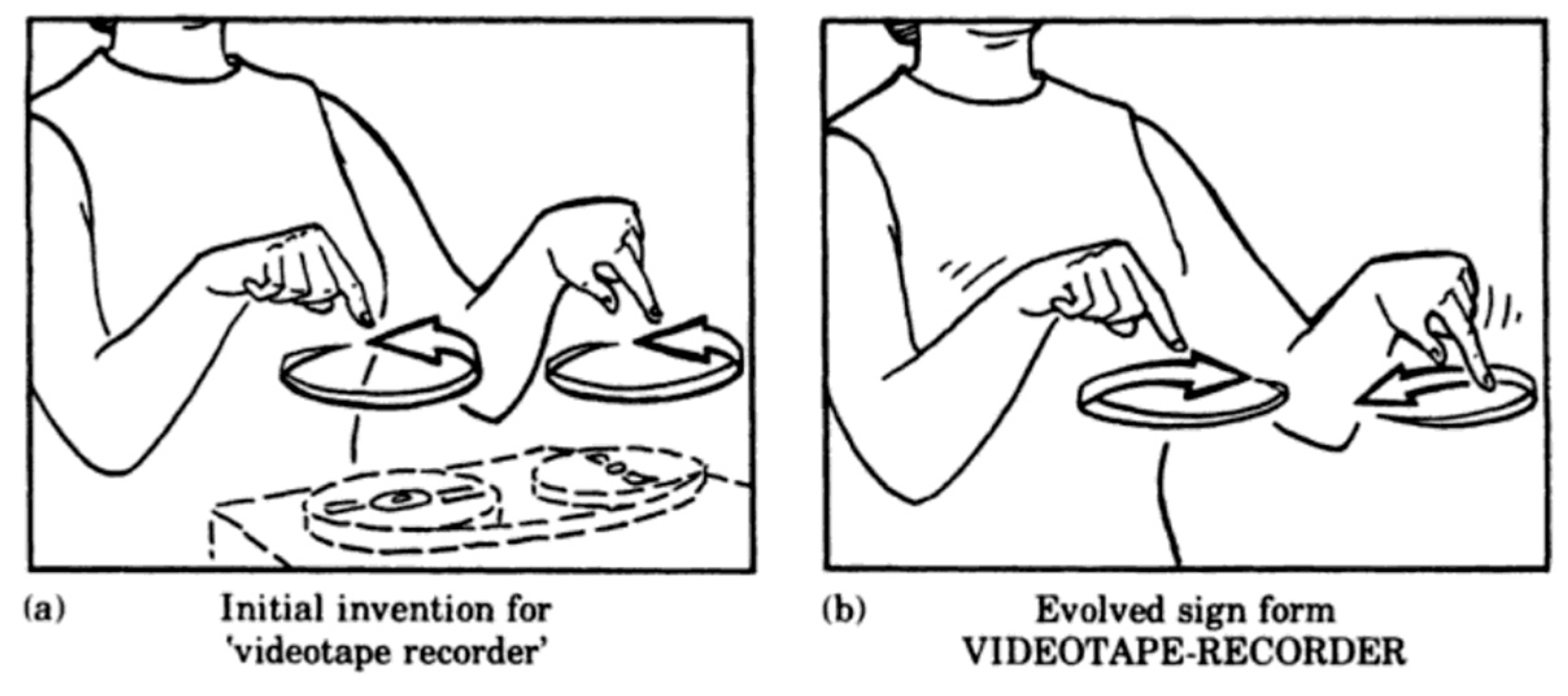
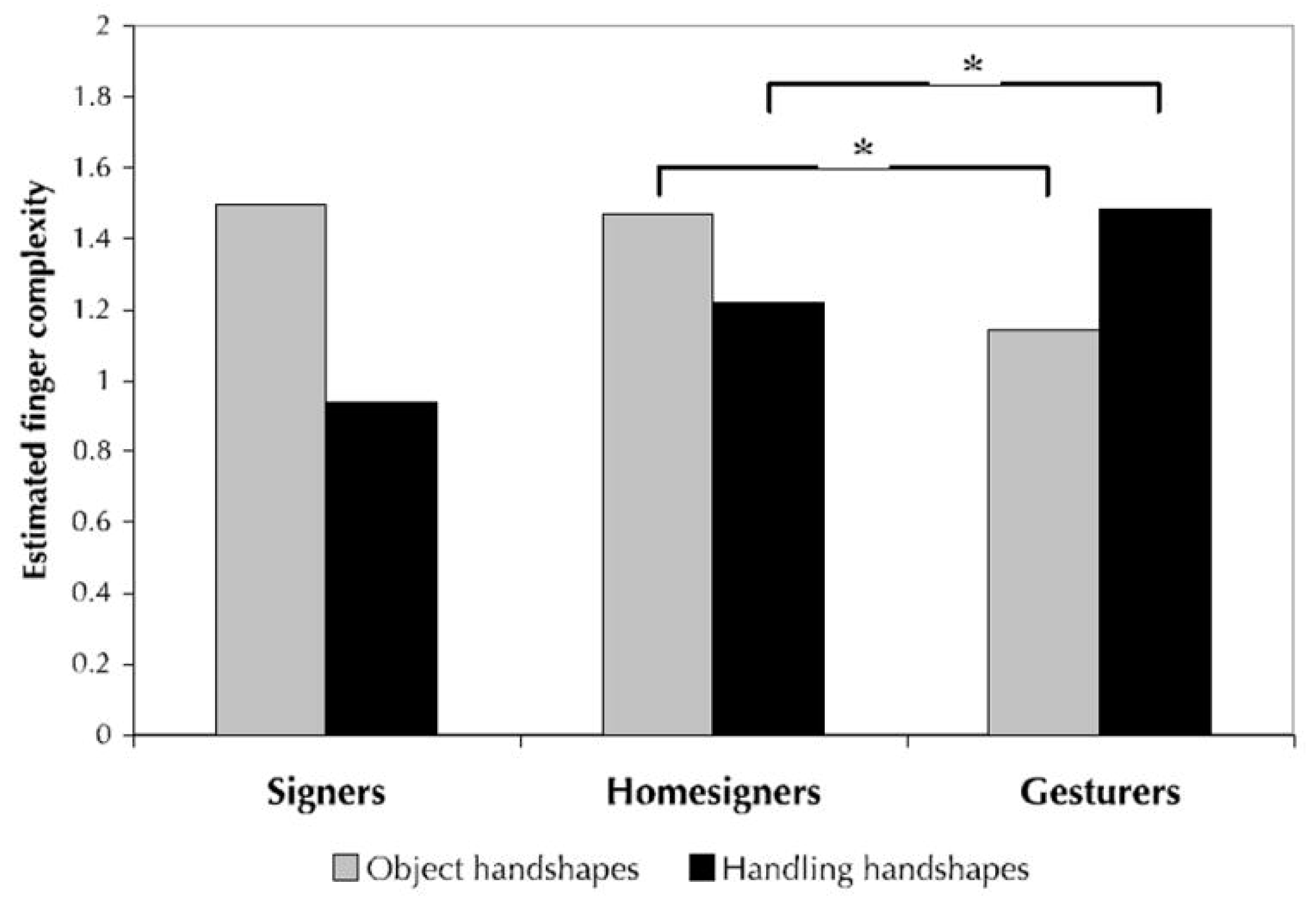

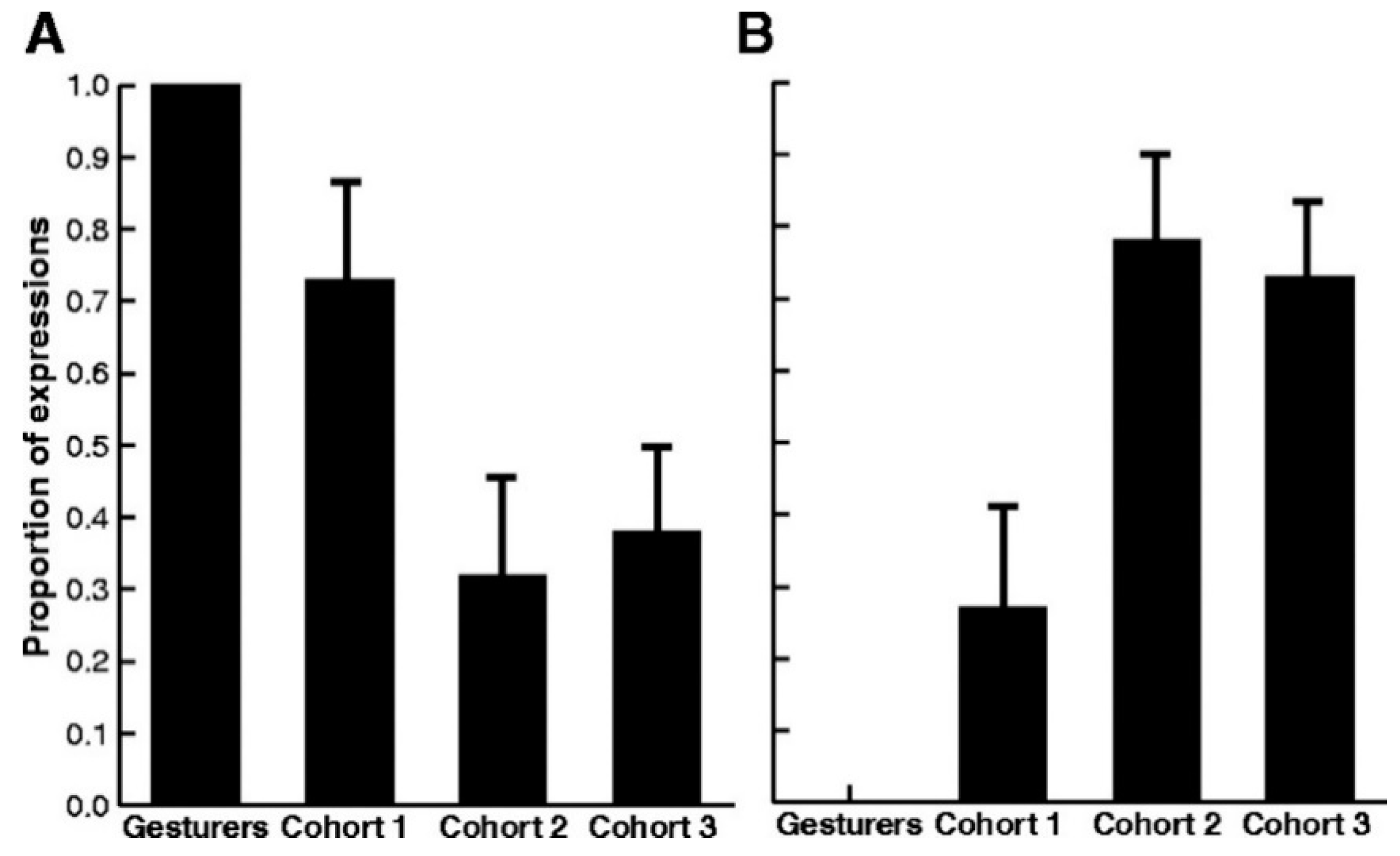
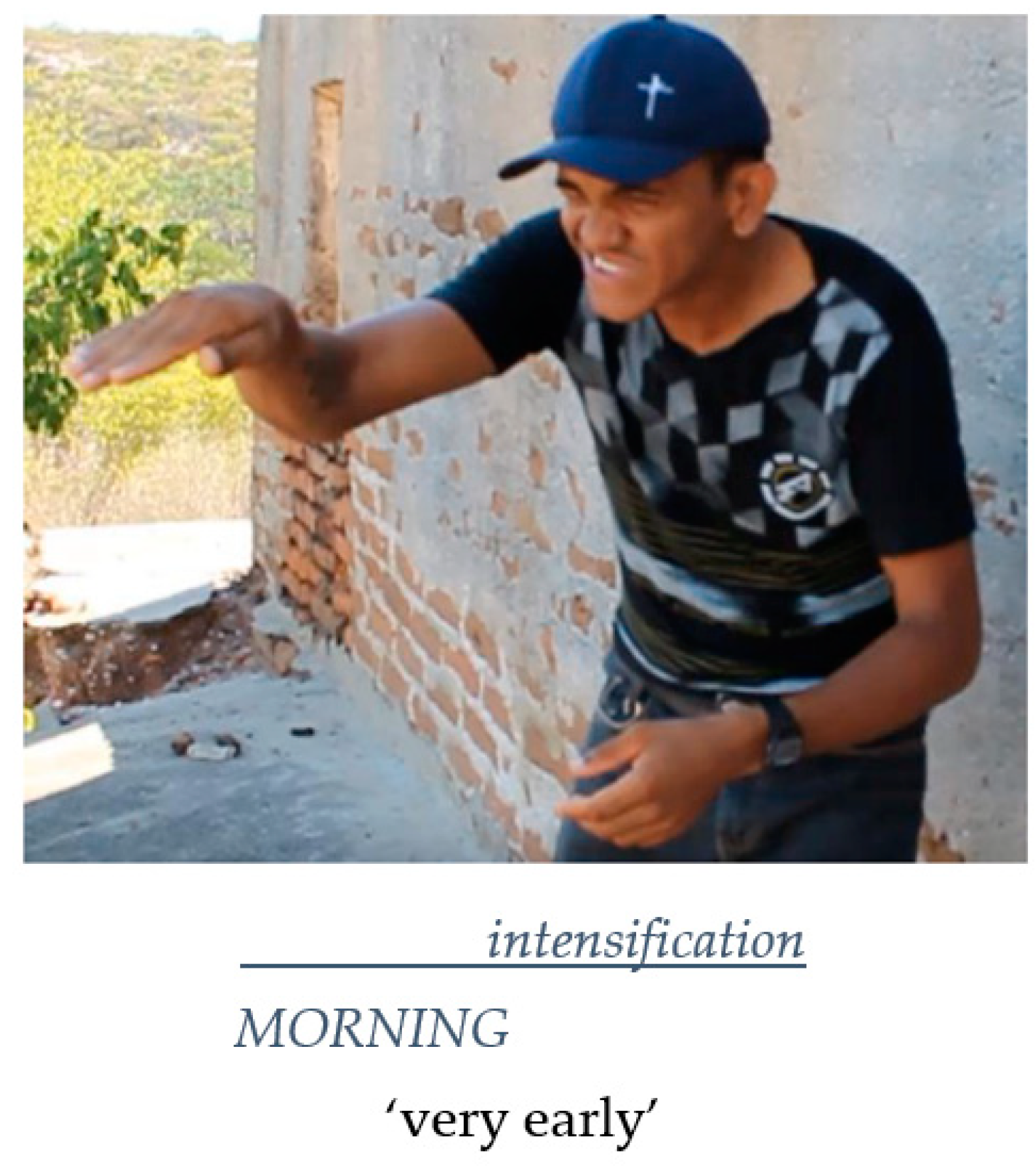

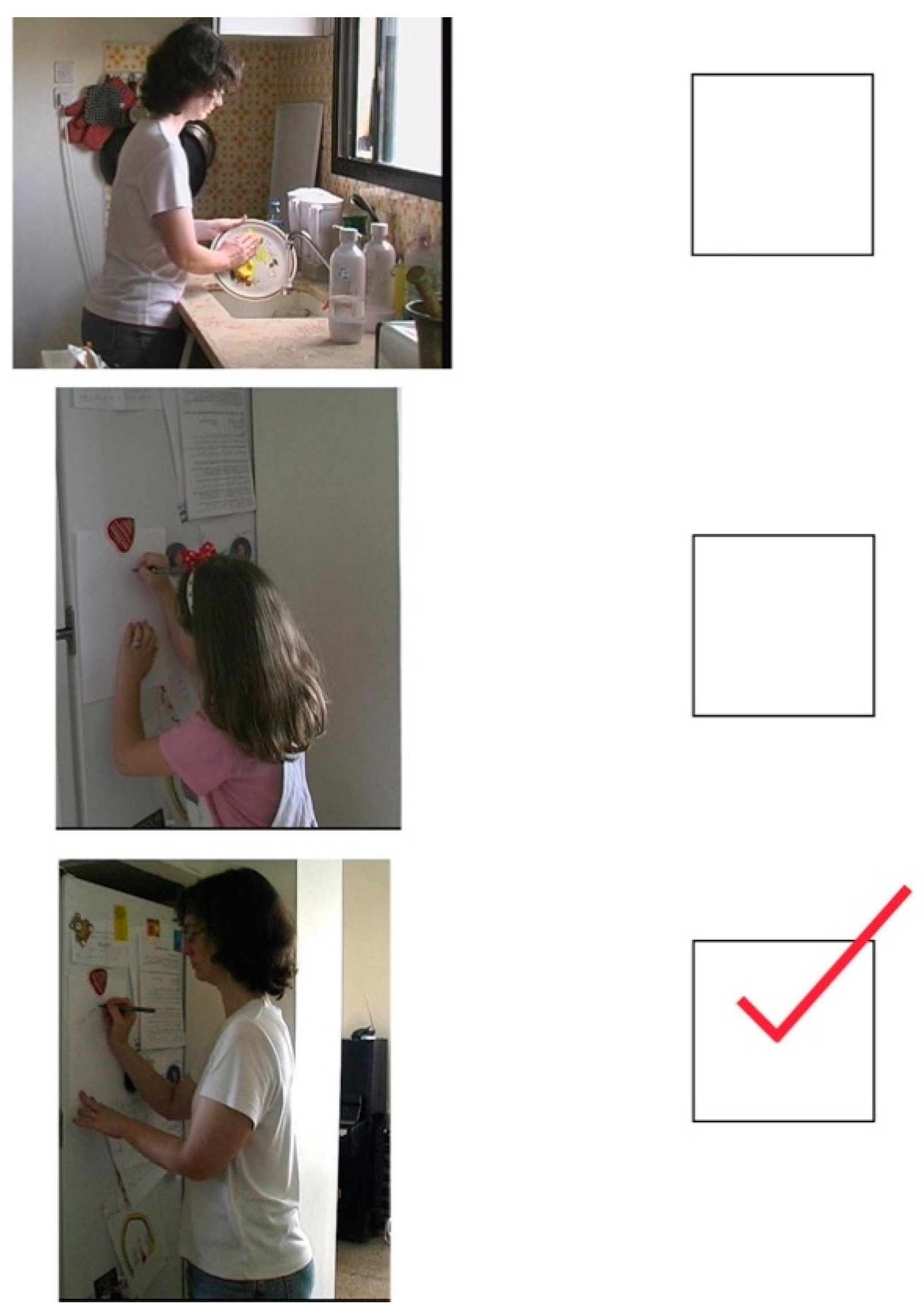

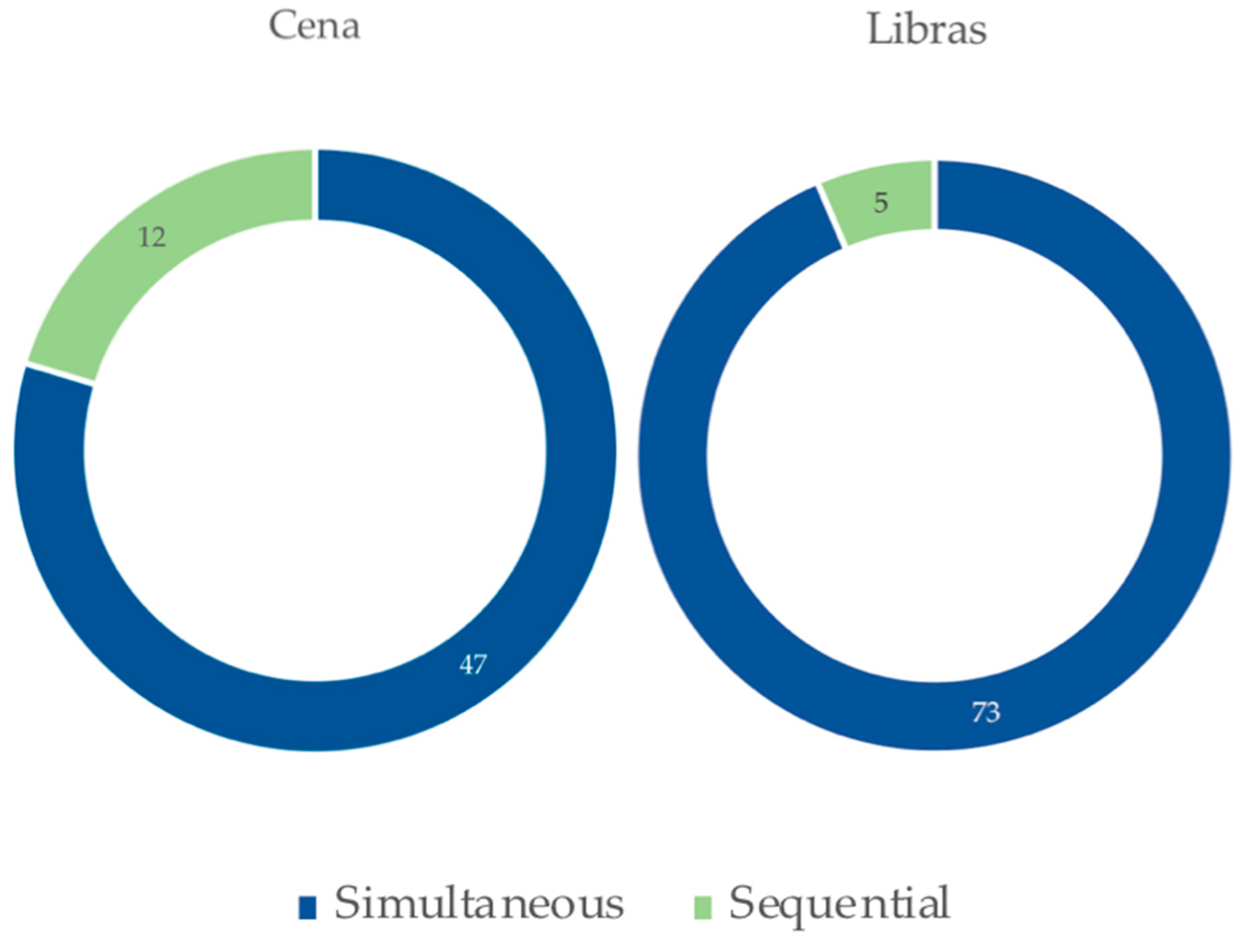
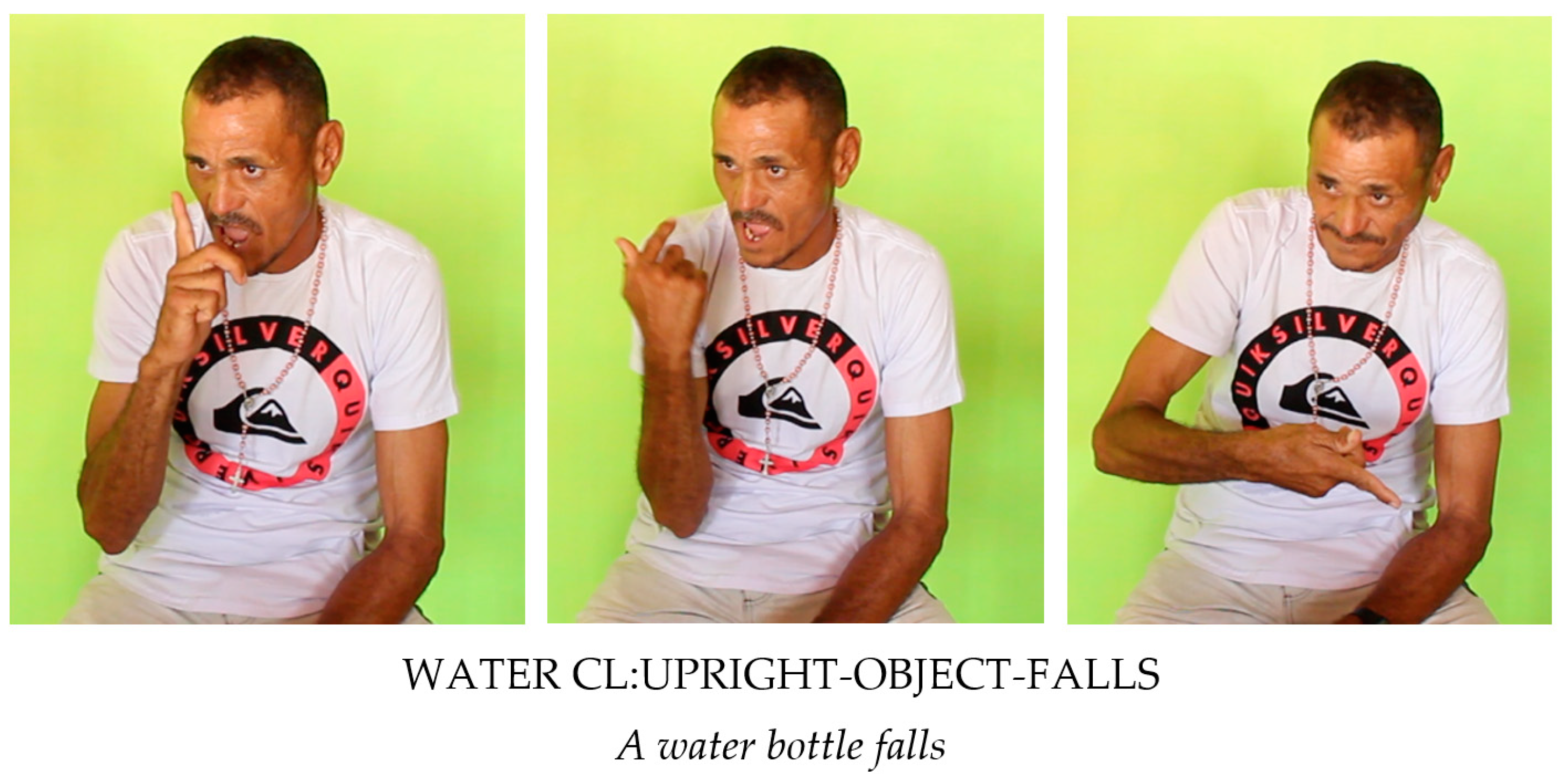
 in an entity classifier.
in an entity classifier.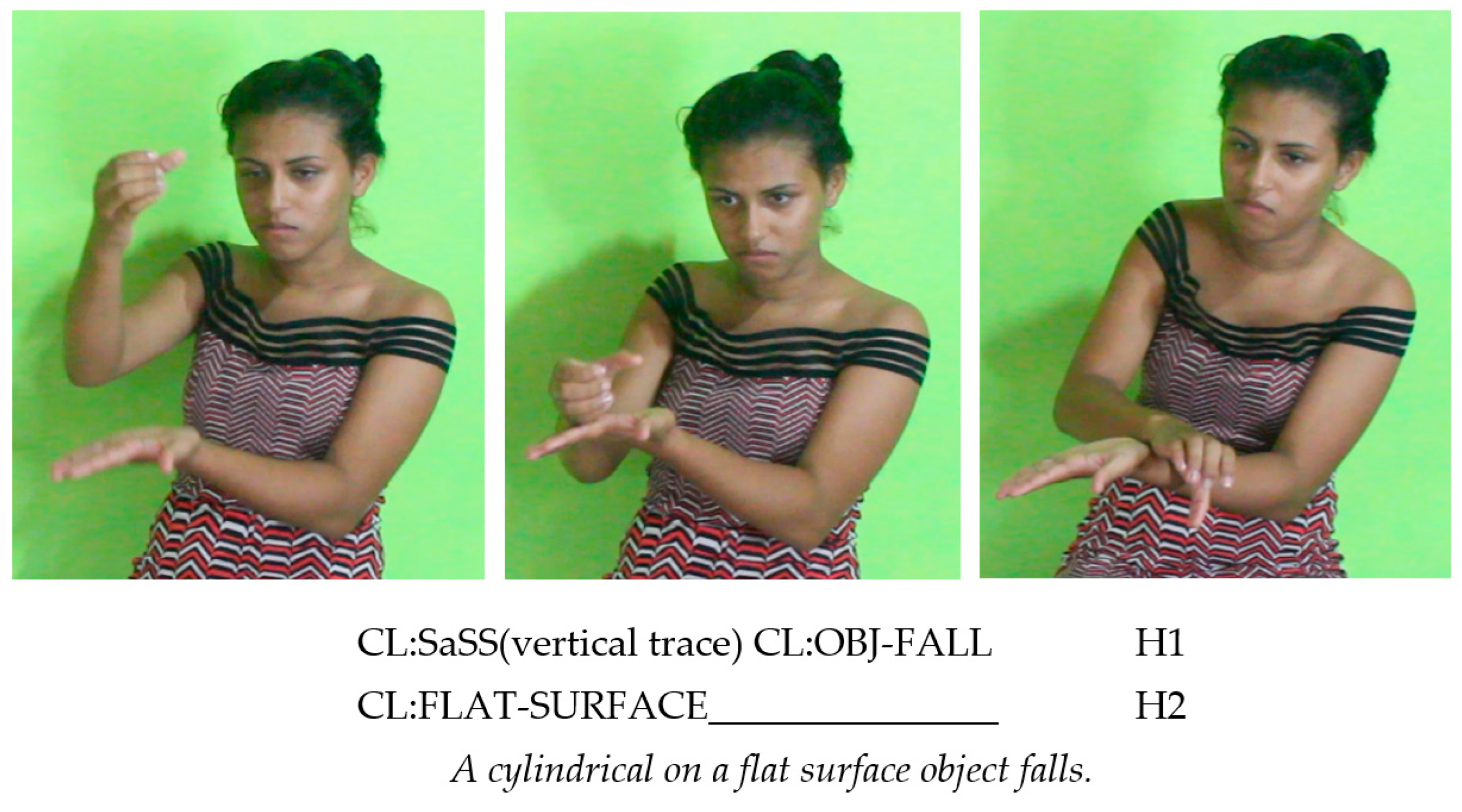
 across several signs.
across several signs.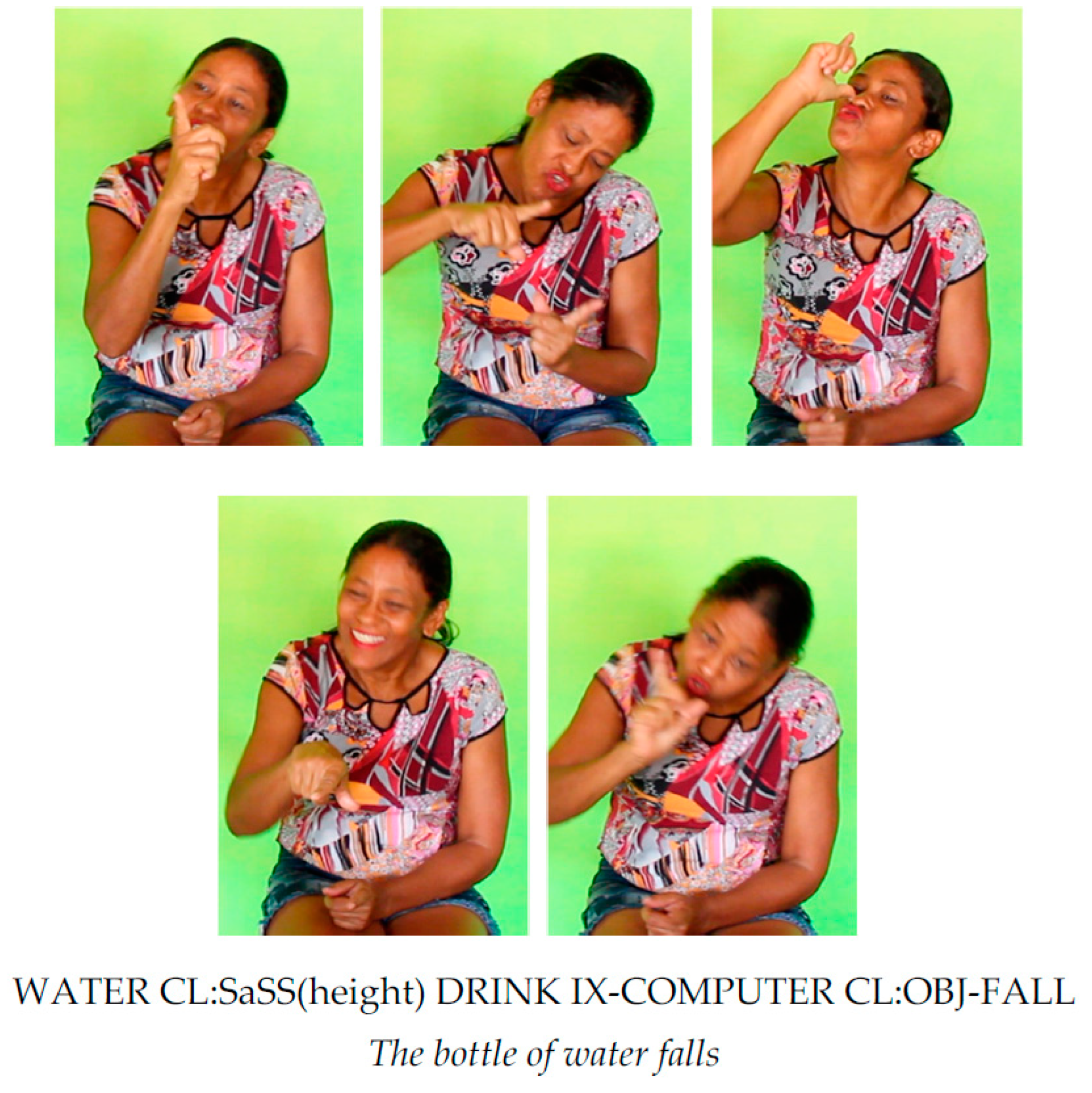

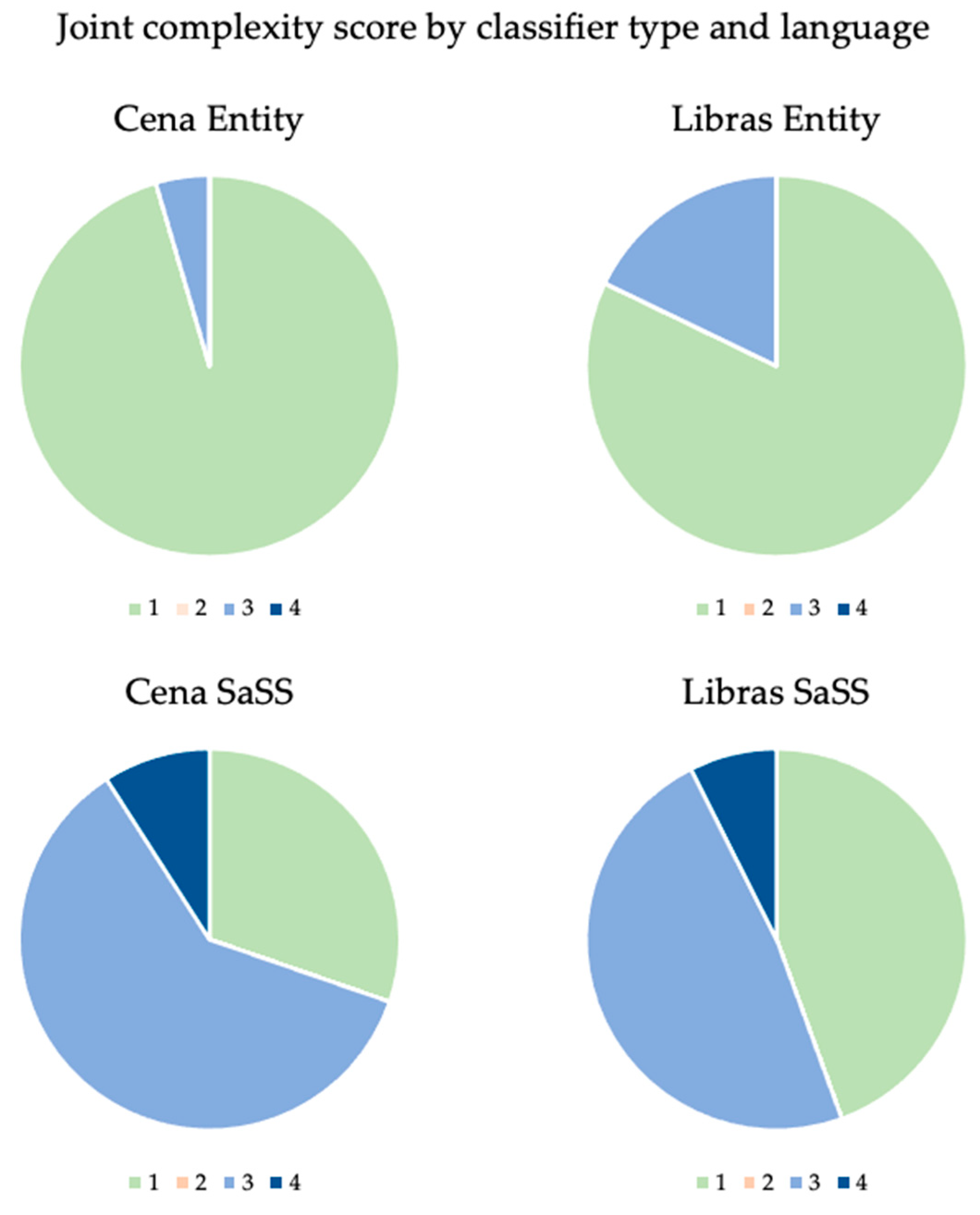
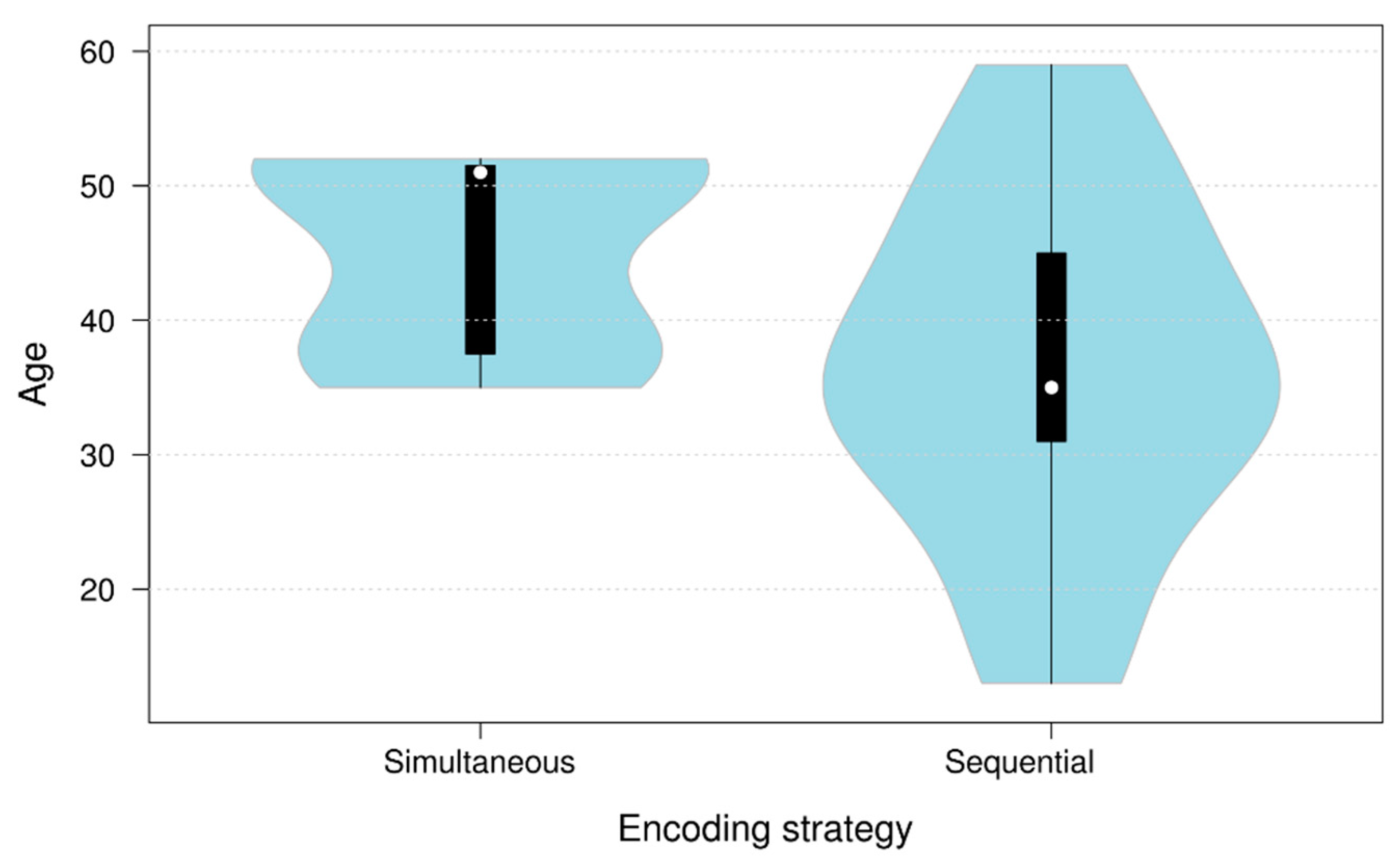
| Finger Complexity | Handshape Examples |
|---|---|
| Low |  |
| Medium |  |
| High |  |
| Joint Complexity | Handshape Examples |
|---|---|
| 1 |  |
| 2 |  |
| 3 |  |
| 4 |  |
| Still Image | Handshape | Tokens | Proportion | No. of Signers |
|---|---|---|---|---|
 |  | 15 | 0.34 | 12 |
 |  | 13 | 0.30 | 10 |
 |  | 11 | 0.25 | 9 |
 |  | 3 | 0.07 | 2 |
 |  | 2 | 0.04 | 1 |
| Still Image | Handshape | Tokens | Proportion | No. of Signers |
|---|---|---|---|---|
 |  | 20 | 0.61 | 9 |
 |  | 6 | 0.18 | 5 |
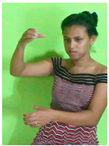 |  | 4 | 0.12 | 1 |
 |  | 3 | 0.09 | 3 |
| Still Image | Handshape | Tokens | Proportion | No. of Signers |
|---|---|---|---|---|
 |  | 15 | 0.53 | 11 |
 |  | 8 | 0.29 | 8 |
 |  | 5 | 0.18 | 3 |
| Still Image | Handshape | Tokens | Proportion | No. of Signers |
|---|---|---|---|---|
 |  | 13 | 0.48 | 13 |
 |  | 7 | 0.26 | 5 |
 |  | 5 | 0.19 | 3 |
 |  | 2 | 0.07 | 1 |
| Handshape | Frequency | Finger Complexity | Joint Complexity |
|---|---|---|---|
 | 0.34 | Low | 1 |
 | 0.30 | Low 1 | 1 |
 | 0.25 | Low | 1 |
 | 0.07 | Medium | 1 |
 | 0.04 | Low | 4 |
| Handshape | Proportion | Finger Complexity | Joint Complexity |
|---|---|---|---|
 | 0.61 | Low | 3 |
 | 0.18 | Low | 1 |
 | 0.12 | Low | 1 |
 | 0.09 | High | 4 |
| Handshape | Proportion | Finger Complexity | Joint Complexity |
|---|---|---|---|
 | 0.53 | Low | 1 |
 | 0.29 | Low | 1 |
 | 0.18 | Low | 3 |
| Handshape | Frequency | Finger Complexity | Joint Complexity |
|---|---|---|---|
 | 0.48 | Low | 3 |
 | 0.26 | Low | 1 |
 | 0.19 | Low | 1 |
 | 0.07 | High | 4 |
| Ball Bouncing | Ball Rolling | Girl Running in Circle | Woman Walking | Woman Running | |
|---|---|---|---|---|---|
| Sim. | 9 | 1 | 12 | 16 | 9 |
| Seq. | 0 | 0 | 4 | 1 | 7 |
| Ball Bouncing | Ball Rolling | Girl Running in Circle | Woman Walking | Woman Running | |
|---|---|---|---|---|---|
| Sim. | 16 | 8 | 17 | 18 | 14 |
| Seq. | 0 | 1 | 1 | 0 | 3 |
Publisher’s Note: MDPI stays neutral with regard to jurisdictional claims in published maps and institutional affiliations. |
© 2022 by the authors. Licensee MDPI, Basel, Switzerland. This article is an open access article distributed under the terms and conditions of the Creative Commons Attribution (CC BY) license (https://creativecommons.org/licenses/by/4.0/).
Share and Cite
Stoianov, D.; da Silva, D.S.; Freitas, J.C.N.; Almeida-Silva, A.; Nevins, A. Comparing Iconicity Trade-Offs in Cena and Libras during a Sign Language Production Task. Languages 2022, 7, 98. https://doi.org/10.3390/languages7020098
Stoianov D, da Silva DS, Freitas JCN, Almeida-Silva A, Nevins A. Comparing Iconicity Trade-Offs in Cena and Libras during a Sign Language Production Task. Languages. 2022; 7(2):98. https://doi.org/10.3390/languages7020098
Chicago/Turabian StyleStoianov, Diane, Diná Souza da Silva, Jó Carlos Neves Freitas, Anderson Almeida-Silva, and Andrew Nevins. 2022. "Comparing Iconicity Trade-Offs in Cena and Libras during a Sign Language Production Task" Languages 7, no. 2: 98. https://doi.org/10.3390/languages7020098






